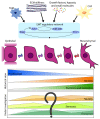Epithelial-to-Mesenchymal Transition in the Light of Plasticity and Hybrid E/M States
- PMID: 34072345
- PMCID: PMC8197992
- DOI: 10.3390/jcm10112403
Epithelial-to-Mesenchymal Transition in the Light of Plasticity and Hybrid E/M States
Abstract
Epithelial-to-mesenchymal transition (EMT) is a cellular program which leads to cells losing epithelial features, including cell polarity, cell-cell adhesion and attachment to the basement membrane, while gaining mesenchymal characteristics, such as invasive properties and stemness. This program is involved in embryogenesis, wound healing and cancer progression. Over the years, the role of EMT in cancer progression has been heavily debated, and the requirement of this process in metastasis even has been disputed. In this review, we discuss previous discrepancies in the light of recent findings on EMT, plasticity and hybrid E/M states. Moreover, we highlight various tumor microenvironmental cues and cell intrinsic signaling pathways that induce and sustain EMT programs, plasticity and hybrid E/M states. Lastly, we discuss how recent findings on plasticity, especially on those that enable cells to switch between hybrid E/M states, have changed our understanding on the role of EMT in cancer metastasis, stemness and therapy resistance.
Keywords: EMP; epithelia-to-mesenchymal transition (EMT); hybrid E/M states; plasticity; stemness; therapy resistance; tumor progression.
Conflict of interest statement
The authors declare no conflict of interest.
Figures
References
Publication types
Grants and funding
LinkOut - more resources
Full Text Sources



